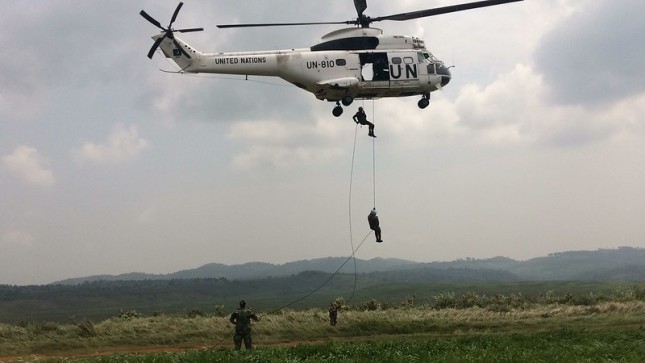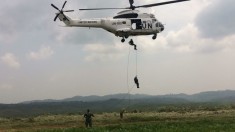-
It’s Time We Think Beyond “Threat Multiplier” to Address Climate and Security
January 21, 2020 By Josh Busby If you have even a passing familiarity with the climate and security literature, you undoubtedly have come across the phrase “threat multiplier.” The phrase conveys the idea that climate change intersects with other factors to contribute to security problems. It’s used as short-hand to avoid the charge of environmental determinism, that climate change somehow on its own causes negative security outcomes.
If you have even a passing familiarity with the climate and security literature, you undoubtedly have come across the phrase “threat multiplier.” The phrase conveys the idea that climate change intersects with other factors to contribute to security problems. It’s used as short-hand to avoid the charge of environmental determinism, that climate change somehow on its own causes negative security outcomes.The 2007 CNA Military Advisory Board (MAB) report on climate security introduced this formulation and, at the time, it served the purpose of recognizing that there is a link between climate change and security. But research on climate security has progressed and so must our framing of the risks and needed interventions.

If you have even a passing familiarity with the climate and security literature, you undoubtedly have come across the phrase “threat multiplier.” The phrase conveys the idea that climate change intersects with other factors to contribute to security problems. It’s used as short-hand to avoid the charge of environmental determinism, that climate change somehow on its own causes negative security outcomes.
The 2007 CNA Military Advisory Board (MAB) report on climate security introduced this formulation and, at the time, it served the purpose of recognizing that there is a link between climate change and security. But research on climate security has progressed and so must our framing of the risks and needed interventions.
As Nina von Uexkull and I argued in Foreign Affairs, the language of threat multiplier doesn’t tell you much about what combination of factors we should be worried about. If we can’t say more than bad things go together, then what can we say about what to do to diminish the negative security consequences of climate change?
Can we do better?
An enduring finding from the conflict studies literature is that societies with a history of conflict are the most likely to experience its reoccurrence. One of the emergent findings from the academic literature on climate and security is that the risk of conflict is greatest in agriculturally dependent societies that exhibit high political exclusion, in other words places where some groups have no representation in government.
So what happens when we apply the emerging climate security research to a risk analysis? To find out, von Uexkull and I wrote a back of the envelope risk analysis of countries that had a recent history of conflict, a large percentage of their workforce employed in agriculture, and exhibited high levels of political exclusion. We coupled that analysis with data on places that recently had, or were projected to have water deficits in the near future. We found that twenty countries in the world—many of them in the Sahel—are perennially at risk of conflict and/or humanitarian emergencies based on their conflict history and agriculture dependence. Of these twenty countries, eleven faced severe short-term water deficits in late 2018 and early 2019.
While this is a crude measure of risk factors, we think it offers an instructive path forward. By identifying countries most at risk of conflict and/or humanitarian emergencies and assessing their vulnerabilities, one could identify context-specific interventions that diminish risks, including food or income support as well as longer-term strategies to diversify income and to enhance political inclusion.
The combination of drivers we used to analyze risk is but one plausible pathway to negative outcomes. Other ideas emerge from climate security research, including the expert elicitation work led by Katharine Mach, which identified low socioeconomic development, diminished state capacity, and intergroup inequality as other important drivers of conflict.
Where does that leave us?
Climate hazards come in different forms and over different timescales, from swift onset cyclones and floods to slow onset droughts. Violent conflict is just one potential security outcome. As I have argued for many years, humanitarian emergencies are also a security concern. And even conflict can take a variety of forms, from rebel violence to conflict between groups.
Understanding what factors make negative security outcomes more likely in the wake of exposure to different climate hazards is part of the analytical challenge. The second piece is understanding what interventions diminish those risks. While state capacity and inter-group inequality may be common risk factors for multiple climate hazards, other risk factors—for example, something as specific as building codes—might only be relevant in certain circumstances, such as whether a cyclone leads to large-scale loss of life.
The scholarship on transboundary water resources offers a useful parallel. What has emerged from the research on transboundary water resources is a set of guiding principles that identify factors that make conflict over water more likely; for example, when a country unilaterally builds a dam that impacts water availability downstream or if there are sudden changes in water quality or quantity. The literature also recognizes what types of interventions are most effective, such as water management institutions that serve as shock absorbers by having processes to allocate water, deal with supply disruptions, and resolve disputes.
Research on climate security has made great strides since the MAB first identified climate change as a threat multiplier. To advance the conversation in a way that informs effective policies and interventions, it’s time we identify a set of commonly understood risk factors and develop a suite of interventions that, when applied, make negative security outcomes less likely. My hope is that the next generation of talented scholars and practitioners are headed in that direction.
Joshua Busby is Associate Professor at the LBJ School of Public Affairs at the University of Texas at Austin, a Distinguished Scholar at the Robert Strauss Center for International Security and Law, and a Senior Research Fellow at the Center for Climate and Security.
Sources: Politico, CNA, Foreign Affairs, Peace Research Institute Oslo, PNAS, Nature, Brookings Institution, Council on Foreign Relations
Photo Credit: Kavumu, South Kivu, DR Congo, January 2018. MONUSCO troops from the Egyptian Special Forces Contingent conducting tactical training to enhance their responsiveness in dealing with armed groups as outlined in the mandate. Photo courtesy of MONUSCO/Force.
 A Publication of the Stimson Center.
A Publication of the Stimson Center.

 If you have even a passing familiarity with the climate and security literature, you undoubtedly have come across the phrase “
If you have even a passing familiarity with the climate and security literature, you undoubtedly have come across the phrase “

